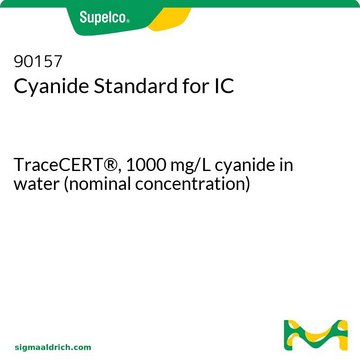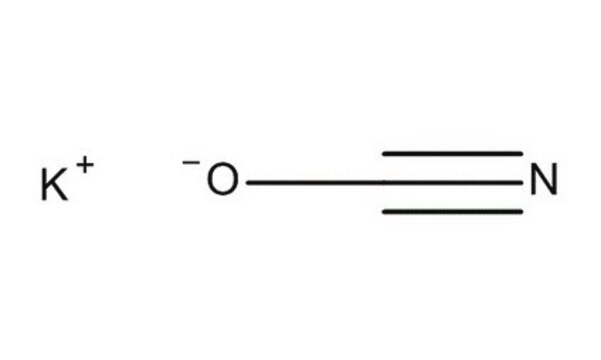11813
Potassium cyanide
technical, ≥96%
About This Item
Produits recommandés
Qualité
technical
Niveau de qualité
Essai
≥96%
Forme
solid
pH
11.5 (20 °C, 20 g/L)
Pf
634 °C (lit.)
Traces de cations
Na: ≤5000 mg/kg
Chaîne SMILES
[K]C#N
InChI
1S/CN.K/c1-2;
Clé InChI
YUZRZFQHUCKACF-UHFFFAOYSA-N
Vous recherchez des produits similaires ? Visite Guide de comparaison des produits
Application
- Characterization, antimicrobial and antitumor activity of superoxide dismutase extracted from Egyptian honeybee venom (Apis mellifera lamarckii).: This study explores the extraction and characterization of superoxide dismutase from honeybee venom, highlighting its antimicrobial and antitumor properties. Potassium cyanide was used in the biochemical analysis to understand the enzyme′s activity and stability (Abdel-Monsef et al., 2023).
- Cytochromes P450 2C8 and 3A Catalyze the Metabolic Activation of the Tyrosine Kinase Inhibitor Masitinib.: This research investigates the metabolic pathways of masitinib, focusing on the role of cytochromes P450. Potassium cyanide is used to inhibit specific enzymatic activities during the analysis, providing insights into drug metabolism and potential toxicological impacts (Latham et al., 2022).
- Profiling of in vivo, in vitro and reactive zorifertinib metabolites using liquid chromatography ion trap mass spectrometry.: The study details the metabolic profiling of zorifertinib using advanced chromatographic techniques. Potassium cyanide serves as an analytical reagent to assess the stability and reactivity of various metabolites (Al-Shakliah et al., 2022).
- Structural and Biochemical Characterization of a Dye-Decolorizing Peroxidase from Dictyostelium discoideum.: The research characterizes a peroxidase enzyme from Dictyostelium discoideum, utilizing potassium cyanide in the enzymatic assays to inhibit specific reactions and better understand the enzyme′s functionality (Rai et al., 2021).
Mention d'avertissement
Danger
Mentions de danger
Conseils de prudence
Classification des risques
Acute Tox. 1 Oral - Acute Tox. 2 Dermal - Acute Tox. 2 Inhalation - Aquatic Acute 1 - Aquatic Chronic 1 - Met. Corr. 1 - STOT RE 1
Organes cibles
Thyroid
Risques supp
Code de la classe de stockage
6.1A - Combustible acute toxic Cat. 1 and 2 / very toxic hazardous materials
Classe de danger pour l'eau (WGK)
WGK 3
Point d'éclair (°F)
Not applicable
Point d'éclair (°C)
Not applicable
Faites votre choix parmi les versions les plus récentes :
Déjà en possession de ce produit ?
Retrouvez la documentation relative aux produits que vous avez récemment achetés dans la Bibliothèque de documents.
Les clients ont également consulté
Notre équipe de scientifiques dispose d'une expérience dans tous les secteurs de la recherche, notamment en sciences de la vie, science des matériaux, synthèse chimique, chromatographie, analyse et dans de nombreux autres domaines..
Contacter notre Service technique

![Cyanide standard solution traceable to SRM from NIST K₂[Zn(CN)₄] in H₂O 1000 mg/l CN Certipur®](/deepweb/assets/sigmaaldrich/product/images/920/032/af45eec3-100b-4996-8eb3-c3942d441bc9/640/af45eec3-100b-4996-8eb3-c3942d441bc9.jpg)













